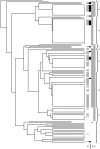Genetic diversity of clinical and environmental Vibrio parahaemolyticus strains from the Pacific Northwest
- PMID: 23042162
- PMCID: PMC3502901
- DOI: 10.1128/AEM.01531-12
Genetic diversity of clinical and environmental Vibrio parahaemolyticus strains from the Pacific Northwest
Abstract
Since 1997, cases of Vibrio parahaemolyticus-related gastroenteritis from the consumption of raw oysters harvested in Washington State have been higher than historical levels. These cases have shown little or no correlation with concentrations of potentially pathogenic V. parahaemolyticus (positive for the thermostable direct hemolysin gene, tdh) in oysters, although significant concentrations of tdh(+) V. parahaemolyticus strains were isolated from shellfish-growing areas in the Pacific Northwest (PNW). We compared clinical and environmental strains isolated from the PNW to those from other geographic regions within the United States and Asia for the presence of virulence-associated genes, including the thermostable direct hemolysin (tdh), the thermostable-related hemolysin (trh), urease (ureR), the pandemic group specific markers orf8 and toxRS, and genes encoding both type 3 secretion systems (T3SS1 and T3SS2). The majority of clinical strains from the PNW were positive for tdh, trh, and ureR genes, while a significant proportion of environmental isolates were tdh(+) but trh negative. Hierarchical clustering grouped the majority of these clinical isolates into a cluster distinct from that including the pandemic strain RIMD2210633, clinical isolates from other geographical regions, and tdh(+), trh-negative environmental isolates from the PNW. We detected T3SS2-related genes (T3SS2β) in environmental strains that were tdh and trh negative. The presence of significant concentrations of tdh(+), trh-negative environmental strains in the PNW that have not been responsible for illness and T3SS2β in tdh- and trh-negative strains emphasizes the diversity in this species and the need to identify additional virulence markers for this bacterium to improve risk assessment tools for the detection of this pathogen.
Figures

Similar articles
-
Trh (tdh-/trh+) gene analysis of clinical, environmental and food isolates of Vibrio parahaemolyticus as a tool for investigating pathogenicity.Int J Food Microbiol. 2016 May 16;225:43-53. doi: 10.1016/j.ijfoodmicro.2016.02.016. Epub 2016 Mar 2. Int J Food Microbiol. 2016. PMID: 26990408
-
Genomic Features of Environmental and Clinical Vibrio parahaemolyticus Isolates Lacking Recognized Virulence Factors Are Dissimilar.Appl Environ Microbiol. 2015 Dec 4;82(4):1102-1113. doi: 10.1128/AEM.03465-15. Print 2016 Feb 15. Appl Environ Microbiol. 2015. PMID: 26637607 Free PMC article.
-
Systematic functional pandemic strain-specific genes, three genomic islands, two T3SSs in foodborne, and clinical Vibrio parahaemolyticus isolates in China.Foodborne Pathog Dis. 2009 Jul-Aug;6(6):689-98. doi: 10.1089/fpd.2009.0274. Foodborne Pathog Dis. 2009. PMID: 19425827
-
[Molecular genetic makers for Vibrio parahaemolyticus--a review].Wei Sheng Wu Xue Bao. 2015 Jan 4;55(1):12-21. Wei Sheng Wu Xue Bao. 2015. PMID: 25958678 Review. Chinese.
-
Roles of thermostable direct hemolysin (TDH) and TDH-related hemolysin (TRH) in Vibrio parahaemolyticus.Front Microbiol. 2015 Jan 22;5:805. doi: 10.3389/fmicb.2014.00805. eCollection 2014. Front Microbiol. 2015. PMID: 25657643 Free PMC article. Review.
Cited by
-
Population structure of clinical and environmental Vibrio parahaemolyticus from the Pacific Northwest coast of the United States.PLoS One. 2013;8(2):e55726. doi: 10.1371/journal.pone.0055726. Epub 2013 Feb 7. PLoS One. 2013. PMID: 23409028 Free PMC article.
-
MALDI-TOF mass spectrometry-based serotyping of V. parahaemolyticus isolated from the Zhejiang province of China.BMC Microbiol. 2018 Nov 13;18(1):185. doi: 10.1186/s12866-018-1328-z. BMC Microbiol. 2018. PMID: 30424744 Free PMC article.
-
Distribution and dynamics of epidemic and pandemic Vibrio parahaemolyticus virulence factors.Front Cell Infect Microbiol. 2013 Dec 11;3:97. doi: 10.3389/fcimb.2013.00097. eCollection 2013. Front Cell Infect Microbiol. 2013. PMID: 24377090 Free PMC article. Review.
-
Comparative Genomic Analysis of Vibrio diabolicus and Six Taxonomic Synonyms: A First Look at the Distribution and Diversity of the Expanded Species.Front Microbiol. 2018 Aug 15;9:1893. doi: 10.3389/fmicb.2018.01893. eCollection 2018. Front Microbiol. 2018. PMID: 30158916 Free PMC article.
-
Vibrio parahaemolyticus: a review on the pathogenesis, prevalence, and advance molecular identification techniques.Front Microbiol. 2014 Dec 11;5:705. doi: 10.3389/fmicb.2014.00705. eCollection 2014. Front Microbiol. 2014. PMID: 25566219 Free PMC article. Review.
References
-
- Alam MJ, Miyoshi S-I, Shinoda S. 2003. Studies on pathogenic Vibrio parahaemolyticus during a warm weather season in the Seto Inland Sea, Japan. Environ. Microbiol. 5:706–710 - PubMed
-
- Bej AK, et al. 1999. Detection of total and hemolysin-producing Vibrio parahaemolyticus in shellfish using multiplex PCR amplification of tl, tdh and trh. J. Microbiol. Methods 36:215–225 - PubMed
-
- Bhattacharjee RN, et al. 2006. VP1686, a Vibrio type III secretion protein, induces toll-like receptor-independent apoptosis in macrophage through NF-κB inhibition. J. Biol. Chem. 281:36897–36904 - PubMed
-
- Brieman L. 2001. Random forests. Machine Learning 45:5–32
Publication types
MeSH terms
Substances
LinkOut - more resources
Full Text Sources
Molecular Biology Databases

